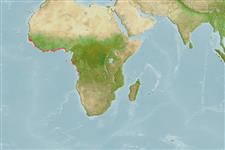Environment: milieu / climate zone / depth range / distribution range
Ekologi
marina; sötvatten; brackvatten bottenlevande; amfidrom. Tropical; 17°N - 11°S, 17°W - 29°E
Eastern Atlantic: southern Senegal and Guinea-Bissau (Ref. 57403) to Republic of Congo and possibly to Angola (Ref. 79590). Reportedle present in the Chiloango in Cabinda (Angola) (Ref. 120641). Also collected from mangroves at Bula Bemba (lower Congo River) and from Banana (lower Congo River estuary) in Democratic Republic of the Congo (Ref. 12818).
Size / Vikt / Age
Maturity: Lm ? range ? - ? cm
Max length : 13.3 cm SL hane/ej könsbestämd; (Ref. 79590)
Short description
Morfologi | Morfometri
Taggstrålar i ryggfenan (totalt): 7; Mjukstrålar i ryggfenan (totalt): 12-13; Taggstrålar i analfenan 1; Mjukstrålar i analfenan: 12 - 14. Diagnosis: head and body strongly compressed; several rows of fine teeth in upper and lower jaw (Ref. 57403, 79590). Angle of mouth located below center or hind margin of eye (Ref. 57403). Interobital space 27-37% of eye diameter; 17-23 (perhaps up to 26) predorsal scales extending anteriorly to level of preoperculum or just behind eye; upper part of operculum scaled; about 57-69 scales in longitudinal series (54-66 on body and 3-5 scales on caudal fin base); 15-21 scales in rearward transverse series; 1st dorsal fin: VI; second dorsal fin: I,13 (rarely 12); anal fin: I,12-13 (perhaps 14); pectoral fins: 17-20; caudal fin lanceolate, its length about 40% of standard length, with 17 segmented rays, 15 of which are branched (Ref. 57403, 79590).
Coloration: Preserved specimens: head and body generally pale or yellowish with indistinct pigmentation except for a dark triangular patch on operculum and a basicaudal spot; a faint large oval spot below 1st dorsal fin beneath pectoral fin rays often visible; anterior margin of 1st dorsal fin spine with 2-4 black spots; flanks pale with several diffuse dark areas along midline (Ref. 57403, 79590).
Occur inshore, over sand (Ref. 4343, 5299). Marine species also found in brackish waters (Ref. 57403, 79590), including lagoons (Ref. 57403, 79590) and estuaries (Ref. 4343, 5299, 57403, 79590) and in the lower course of streams (Ref. 4343, 5299). Adults may occupy subtidal burrows (Ref. 79590). Maximum reported total length 19.6 cm (Ref. 57403).
Life cycle and mating behavior
Könsmognad | Reproduktion | Lek | Ägg | Fecundity | Larver
Harrison, I.J., P.J. Miller and F. Pezold, 2003. Gobiidae. p. 625-666 In C. Lévêque, D. Paugy and G.G. Teugels (eds.) Faune des poissons d'eaux douce et saumâtres de l'Afrique de l'Ouest, Tome 2. Coll. Faune et Flore tropicales 40. Musée Royal de l'Afrique Centrale, Tervuren, Belgique, Museum National d'Histoire Naturalle, Paris, France and Institut de Recherche pour le Développement, Paris, France. 815 p. (Ref. 57403)
IUCN Red List Status (Ref. 130435)
Threat to humans
Harmless
Human uses
Fiskeri:
Ytterligare information
PopulärnamnsynonymerMetabolikPredatorerEkotoxikologiReproduktionKönsmognadLekSpawning aggregationFecundityÄggEgg development
referenserVattenbrukVattenbruksprofilAvelslinjerGenetikElectrophoresesÄrftlighetSjukdomarBehandlingNutrientsMass conversion
Verktyg
Special reports
Download XML
Internet-källor
Estimates based on models
Preferred temperature (Ref.
123201): 24.4 - 28, mean 26.6 °C (based on 60 cells).
Phylogenetic diversity index (Ref.
82804): PD
50 = 0.5078 [Uniqueness, from 0.5 = low to 2.0 = high].
Bayesian length-weight: a=0.01000 (0.00349 - 0.02862), b=3.09 (2.85 - 3.34), in cm total length, based on LWR estimates for this (Sub)family-body shape (Ref.
93245).
Trofisk nivå (Ref.
69278): 3.5 ±0.5 se; based on size and trophs of closest relatives
Resiliens (Ref.
120179): Hög, lägsta populationsfördubblingstid mindre än 15 månader (Preliminary K or Fecundity.).
Fishing Vulnerability (Ref.
59153): Low vulnerability (10 of 100).
